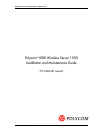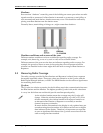
KIRK Wireless Server 1500 Installation and Maintenance
3. Radio Coverage and Physical Deployment
3.1 Radio Coverage Areas
The deployment of Base Stations and Repeaters is a critical aspect of the KWS1500
Wireless Server. If the Wireless Server installation is to be successful, the deployment
concepts explained here must be followed.
To determine the permanent installation location of Base Stations within a given
installation, a site survey must be taken to discover the optimal location and total
quantity of Base Stations required for the installation.
KIRK Base Stations provide a radio coverage radius of approximately 47 meters / 150
feet indoors or up to a 350-foot (106 meters) radius outdoors in direct line-of-sight
conditions. However, it is extremely important to keep in mind that radio coverage is
dependent on construction materials, method of construction and environment. These
factors will always be involved in every installation. Therefore, it is not possible to relate
one installation to another insofar as number of Base Stations or positioning of Base
Stations. Each site is relatively unique.
While an extensive guide to effective RF coverage planning is outside the scope of this
manual, the following points should be taken into consideration when planning the site,
prior to installation.
Specifications listed reflect capacities of the KWS1500 solution when used in a
Solo configuration unless otherwise designated.
• The Base Station provides a typical coverage radius of 150 feet (46 m) in a typical
indoor office environment, and up to a 350-foot (107 m) radius in an open area (line-
of-sight), extending in all directions from the Base Station. The exact coverage range
depends on the building architecture and materials.
• The KWS1500 will support a maximum of 64 handsets per solution. .
• The KWS1500 supports a maximum of 16 Base Stations per solution, providing 64
RF speech channels.
• A maximum of two KWS1500 solutions may be linked together.
• Handsets can move between coverage areas of different Base Stations while receiving
continuous service and maintaining conversations in progress.
• For efficient handoff of conversations between Base Stations, deploy multiple Base
Stations with sufficient overlap of coverage between them (i.e. plan for some areas to
be covered by more than one Base Station). Overlaps are necessary to allow handsets
the time necessary to handoff to a Base Station with a stronger signal.
• Avoid placing Base Stations near other electronic equipment, large machinery, etc.,
as the range can be severely affected.
• Base Stations should be placed between 1,8 and 2,4 meters / 6 and 8 feet in height; if
they are placed any lower, persons walking around could interfere with the radio
signal. Antennas should always be mounted in a vertical orientation utilizing the
supplied mounting bracket. Coverage area can be adversely affected if the Base
Stations is mounted improperly.
3.2 Deployment
It is important to keep in mind that the coverage area of the KWS1500 and any repeater is
flexible and affected b outside objects. It should be noted that within the course of this
72160400_issue_B 8


















